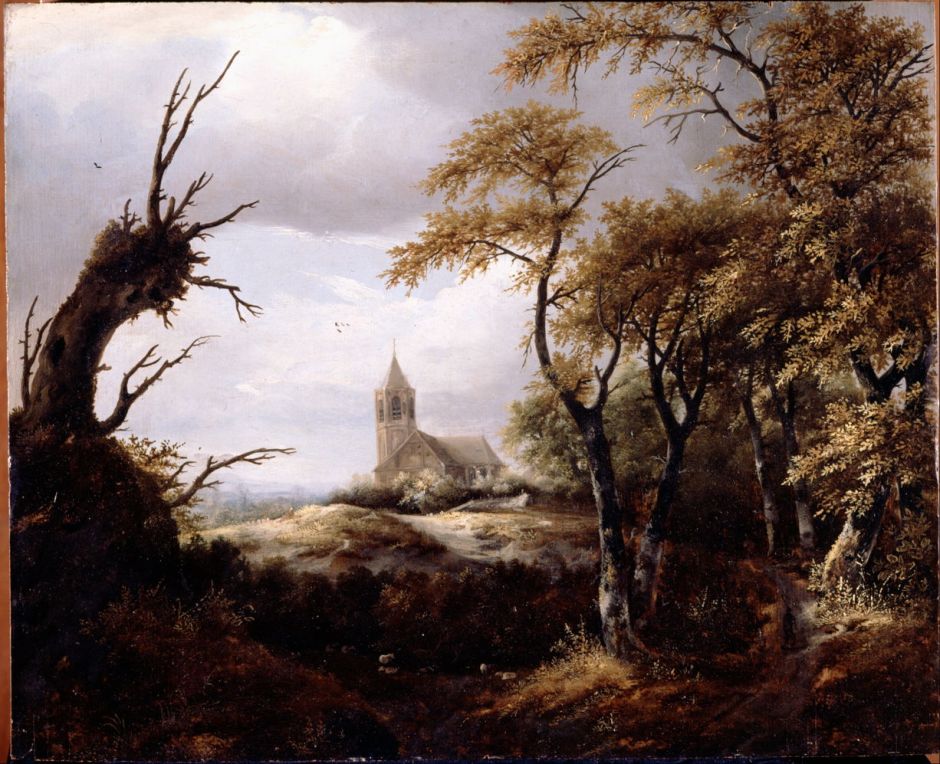Composing a landscape painting so that it gives the appearance of depth was solved thanks to a set of rules originally intended for figurative paintings in the Renaissance. Those traditional principles were first codified in 1604, in Karel van Mander’s Foundation of the Noble Free Art of Painting (Den Grondt der edel vry Schilder-Const). To distinguish a figurative foreground from a landscape background, he advised filling corners but keeping the middle of the image as free as possible to set a more distant view far into the depth of the landscape, with its pictorial content in harmony.
From that arose repoussoir, a French term describing the placing of objects like a tree in the left or right foreground so as to draw attention to the central part of the painting. The foreground object then pushes the distant landscape further away and deeper into the picture. This weekend I show examples of this technique in action.

Giorgione’s pioneering painting of The Tempest in about 1504-8 follows this tradition, and anticipates the use of foreground trees to create repoussoir, which coupled with his linear perspective in buildings, gives this view depth.

Landscape of the Danube near Regensburg is one of Albrecht Altdorfer’s five known pure landscape paintings, and was made between about 1528-30. This further develops repoussoir, and establishes the distinction of foreground, middle distance and far distance, with a low horizon to accommodate the framing trees and allow a dramatic cloudscape.

Diego Velázquez’s pioneering paintings made in front of the motif when he was in Rome in 1630 show the new challenge of landscape composition. If an artist is going to depict what they see in front of them, composition takes place in the selection of the point of view relative to the landscape to be painted. Once the artist has chosen where and what to paint, its composition is largely fixed, in this case with repoussoir. These paintings were also probably the first oil sketches made en plein air, a technique developed later by Pierre-Henri de Valenciennes, then to form the central tenet of Impressionism.

Claude is best-known for his contre-jour views, straight into the setting sun. Embarkation of St Paula is typical of these with its towering classical buildings using repoussoir to give the image depth and drawing the eye from its foreground figures to the low sun.

By the time that Jacob van Ruisdael painted this view of a Landscape with a Church in about 1645, his repoussoir trees were threatening to take over the whole view.

Thomas Gainsborough took a lighter touch in his Wooded Landscape with a Cottage and Shepherd from 1748-50: on the left is a thin sliver hinting that there’s a tree just beyond the edge of the canvas. Its twin on the right is further into the motif, but makes up for that in its engaging character.

Caspar David Friedrich used it from an unconventional angle of view in his Chalk Cliffs on Rügen (after 1818). Here the viewer’s gaze is directed down towards the sea below and beyond the white pinnacles. To make this appear even more vertiginous, Friedrich adds repoussoir from a couple of trees perched on the clifftop, then leans two of his figures against their feet.

Inspired by Claude Lorraine, JMW Turner’s early view of Pope’s Villa, at Twickenham from 1808 is a good example of the left-sided repoussoir convention in all its glory.

A few years later, Turner used stronger repoussoir to make the city of Plymouth seem even more distant as we look down on it in his Crossing the Brook (1815). He draws our gaze deep into that distance by continuing the trees diagonally downwards from the right, leading us to the river which then meanders into the haze.

Samuel Palmer’s The Shearers from about 1833-35 uses the massive beams of a sheepshed to frame the dazzling external landscape.
Tomorrow’s conclusion will show some of the more radical approaches that developed during the later nineteenth century.

